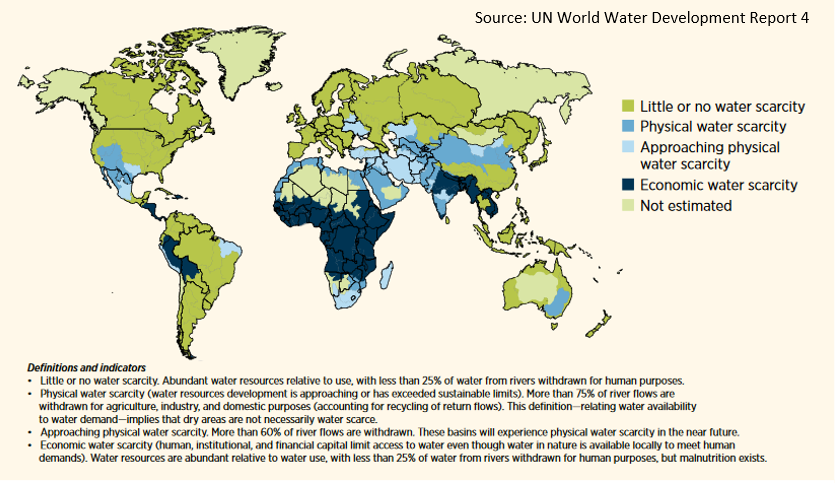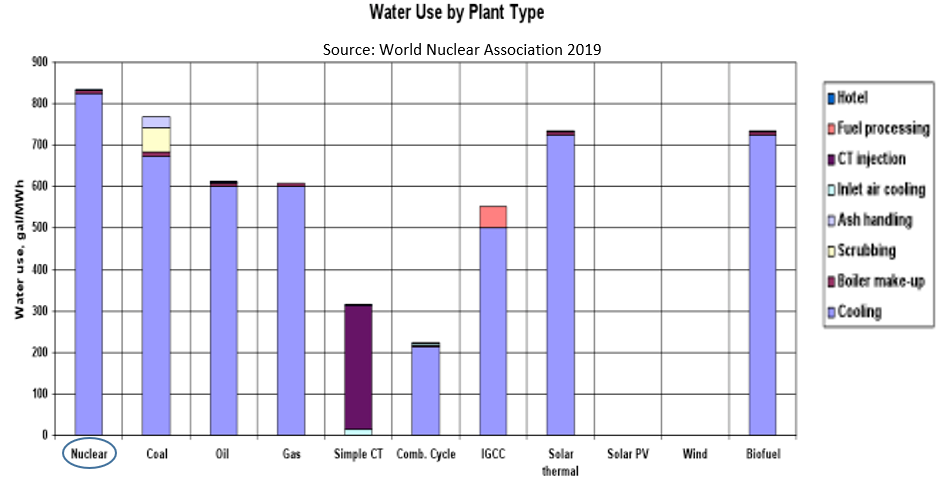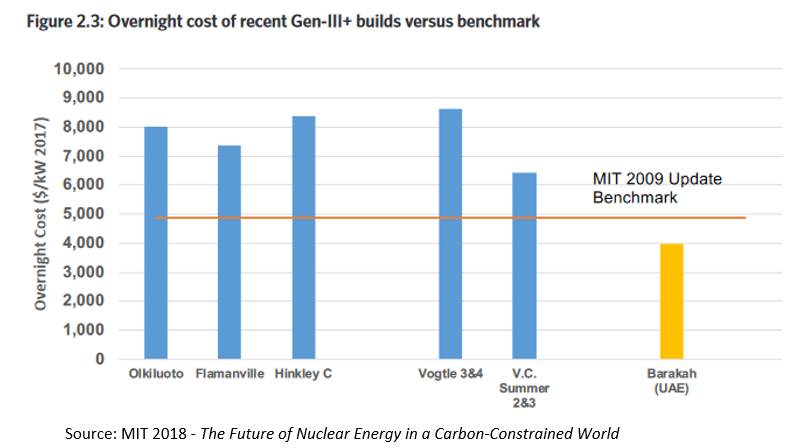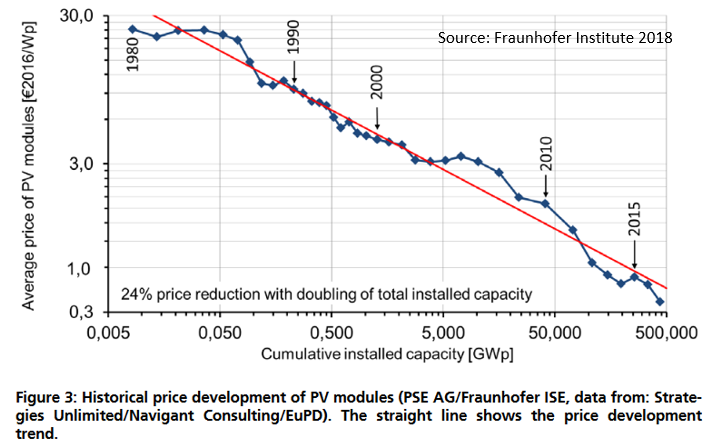PERSPECTIVES #2
A contribution to a Financial Times “Question of the week”: Does it make sense for the kingdom to develop reactors for electricity generation?
Télécharger l’intégralité du document en PDFA contribution to a Financial Times “Question of the week”: Does it make sense for the kingdom to develop reactors for electricity generation? i
The civil nuclear ambitions of Saudi Arabia may seem to make sense at first but does not appear to hold well a deeper level of scrutiny. Indeed, developing nuclear energy would reduce the reliance of the Kingdom on fossil fuels, contribute to maximize hydrocarbons exports and help it abide by its commitments under the Paris agreement. Yet, when looking at the environmental and economic arguments, there are few in favor of Saudi Arabia’s nuclear ambition.
If we consider what may be the three main goals of Saudi Arabia in the energy sector – energy security, maximization of hydrocarbons exports, and environmental targets, developing Renewable Energy Sources (RES) with high efficiency gas combined cycle power plant is probably a more suitable answer to these goals (it is worth reading the excellent 2018 report from Robin Mills for the Non-Proliferation Policy Education center)ii
A first set of arguments is based on geography: Saudi Arabia is a large country with a relatively low population density (15 inhabitants / km²), a vast portion of its territory deserts or mountains, and only 1% of its territory arable land. With over 2600 km of coast, Saudi Arabia has a large access to sea water for cooling purposes. Yet, its fresh water resources are low, considering it receives only 60 mm of rain per year on average (vs. 550 mm for France for example) and its underground water resources deplete quickly (as stated by former vie-minister for agriculture Ali al-Takhees). Overall Saudi Arabia has a major water scarcity challenge, as shown in the map below:

When now looking at nuclear power, it has the strong advantage of providing massive amount of energy on a small portion of land while consuming large volumes of water. These features do not coincide well with the geographic characteristics mentioned above for three reasons:
- Nuclear power requires access to large water resources. Be it water usage (withdrawn from the environment and discharged back) or water consumption (water evaporating in cooling towers), the volumes are the highest in the industry with coal, and not suitable with a country with large desert areas. On the other hand, solar, or wind, do not consume water (or marginally for cleaning panels). The following chart from the World Nuclear Association websiteiii shows water use by type of electricity generation technology:

- Nuclear power plant efficiency and output are all the better that cooling water temperature is low. As a 2018 studyiv tends to show, when the temperature of the cooling water rises above 20°C, power output starts to drop. Sea water temperatures in Jeddah for example, are consistently above 20°C, in fact above 24°C on average, leading mechanically to a lower output and hence a higher cost of electricity.
- Land use is often cited as a deterrent to RES development, in particular as it may reduce agricultural land. Considering that the vast majority of Saudi Arabia’s territory is non-arable, the Kingdom has a rare feature that allows it to develop energy sources unconstrained by space.
The second set of arguments is rooted in electricity economics: it should be carefully assessed whether nuclear helps achieve the least cost sustainable option for its energy system. As Robin Mills summarizes, Saudi Arabia has various goals in shaping its energy policy: it wants to maximize its foreign currencies reserves and build up fiscal reserves, retain OPEC leadership and diversify its domestic economy away from hydrocarbons. Indeed, nuclear power would help achieving these goals. But it is probably not the most efficient path to achieve them.
It may be hard to find an argument for nuclear power over solar developments, in a country where solar resources are above 1500 kwh/kWp, a level equivalent to the best solar resources regions of Europe (Southern Spain and Italy), and may go as high as 2100 kWh/kWp. Furthermore, whereas generally solar power projects are constrained by land use, leading to solar plant designed based on more efficient crystalline technologies, projects in Saudi Arabia could be based on less efficient but cheaper thin film technologies, which also have the advantage of better resistance to high temperatures. We should note also that technological improvements will likely continue to reduce the cost of solar power.
An illustration of the strength of the economic argument in favor of solar power is the electricity cost differential between the latest nuclear and solar developments.
In 2003, the MIT released its first report on The Future of Nuclear Power, which based its analyses on construction costs of 2000 $/kW leading to 67 $/MWh in its base case. In 2009, MIT updated overnight costs at 4000 $/kW, leading to 84 $/MWh of levelized cost of energyv. And yet, in 2018, the MIT released a new reportvi, in which the following chart can be found:

This chart demonstrates the dramatic increases of nuclear plants construction costs, at least in Europe and in the US. The Virgil C. Summer extension was even abandoned in July 2017 following massive cost overruns and Westinghouse’s filing for chapter 11. On the Barakah project, the MIT cautions that there are uncertainties on the actual costs of Barakah, citing among others owner’s costs that may have not been taken into account (20% of total costs). This increase in costs explains why current power purchase agreements for power plants come up at high levels. Hinkley Point has secured a strike price at 92.5 £/MWh (real 2011) over a 35-year period.
In the meantime, solar costs have declined spectacularly. This chart from the Fraunhofer Institutevii shows the uninterrupted trend of strong costs decline of solar since its commercial break out in the 70s.

This sharp decrease in costs, which impacts all regions of the world as it is much less dependent on local construction market specificities, has led to recent power purchases agreements (PPA) on solar at record low prices. In the gulf region in particular, these PPAs have gone as low as 17.9 $/MWh for the 300 MW Sakaka solar power plant in … Saudi Arabia! In Abu Dhabi, ADWEA awarded a 1.2 GW PPA for the Sweihan development at 24.2 $/MWh. One may add to this picture that a critical component of nuclear power plant construction lies in the access to a skilled workforce and the existence of an ecosystem. Whereas the solar sector is backed by a growing ecosystem in Saudi Arabia – and in the world, the nuclear sector is non-existent in the country and would require importing virtually all the skills, putting additional pressure on costs and future operations.
This differential in resulting electricity costs would call for some scrutiny on the relevance of developing a nuclear power plant in the Kingdom. But additional elements would reinforce the relevance of choosing solar over nuclear: nuclear power plants are developed on the backdrop of long term PPA, 60 years for the Barakah power plant in Abu Dhabi. Solar projects on the other hand are based on 20 to 30 years PPA. The implication is that such a large nuclear development provides a 60-year hedge on energy cost evolutions at 60$/MWh in the best case, when competing technologies are reducing constantly the cost of this electricity. We may add to this argument that once built, a nuclear power plant is not designed for significant upgrades but rather for optimizations, while a solar park is quite easy to upgrade with latest generation panels and equipment. The modularity of solar is a compelling advantage in a world of rapid shifts and technological evolution, reinforced by the much shorter construction period of solar plants compared to that of nuclear power plants.
One of the main counter-argument for a massive solar roll-out in Saudi Arabia would be the intermittency of solar power production. Whereas battery storage may be useful but constrained by high temperatures, high efficiency gas power combined cycles could be a valuable solution to balance the RES intermittent production. From a sustainability perspective, it would be all the more attractive that it could be fit well the Kingdom’s endorsement of the World Bank’s “Zero Routine Flaring by 2030” during the Katowice Conference in December 2018viii: as the ninth largest gas flarer in the world, Saudi Arabia could benefit on all counts from using this gas into high efficient gas power plants as a balancing tool for systematic RES deployment.
Additionally, current examples of nuclear developments tend to show that the investment cost overruns and delays can be substantial, but maybe more importantly, often failing to integrate the cost of dismantling and waste disposal in the initial total cost of electricity. Of course, when considering a 60 to 80 years lifetime for the latest generation of nuclear plants, these impacts are minimal due to discounting effects, but they do pose a genuine sustainability issue as the current European example shows. The question could then be: who will pay for these costs if hydrocarbons revenues decline substantially in 60 years from now, and these costs have not been provisioned upfront in a cash reserve? Building this cash reserve, which may seem a prudent thing to do, would in turn increase the cost of electricity from nuclear power.
Finally, nuclear power plants are centralized in essence: once produced, the power needs to be transported on hundreds or thousands of kilometers. Here, two specificities come into play. On the one side, building nuclear power plants on the coast on the red sea would require transporting this power through the mountains to places like Riyad or Medina. On the other side, building a power plant on the gulf coast may pose strategic questions. The strong advantage of renewables coupled with efficient gas power plants is that it draws production nearer to consumption centers, as it is much more granular. This may also bring significant advantages in terms of security of supply by lowering the risk to the system in case of one single plant outage.
Saudi Arabia’s nuclear ambitions do not hold well against a quick analysis on economic and environmental grounds. The Kingdom itself acknowledges the compelling case of Renewables in its “Vision 2030”, by designing a plan to develop 54 GW of mostly solar and wind capacity by 2040. It therefore raises the question of the reasons behind it, and its strategic implications. Eventually, nuclear power seems to have a specific appeal to governments: it is a sign of… power. Power in many aspects, from pure military perspective (as the FT article points out), to sentiment of industrial and technological edge. Building then inaugurating a nuclear power plant will always be a national – even sometimes global – event, to the difference of other power plants (conventional or renewables) and a perceived exhibition of power. And this may be the biggest pitfall.
[i] https://www.ft.com/content/c106c09e-36d5-11e9-bb0c-42459962a812
[ii] http://npolicy.org/Articles/March%202018%20Drafts/Mills_Saudi_Arabia_Feb18.pdf
[iii] http://www.world-nuclear.org/information-library/current-and-future-generation/cooling-power-plants.aspx
[iv] http://www.analys.se/engelska/publications/nuclear-power-high-sea-water-temperatures/
[v] Both 2003 and 2009 reports available here: http://energy.mit.edu/research/future-nuclear-power/
[vi] https://energy.mit.edu/wp-content/uploads/2018/09/The-Future-of-Nuclear-Energy-in-a-Carbon-Constrained-World.pdf
[vii] https://www.ise.fraunhofer.de/content/dam/ise/en/documents/publications/studies/recent-facts-about-photovoltaics-in-germany.pdf
[viii] https://ksa-climate.com/saudi-arabia-endorses-world-banks-zero-routine-flaring-by-2030-initiative/